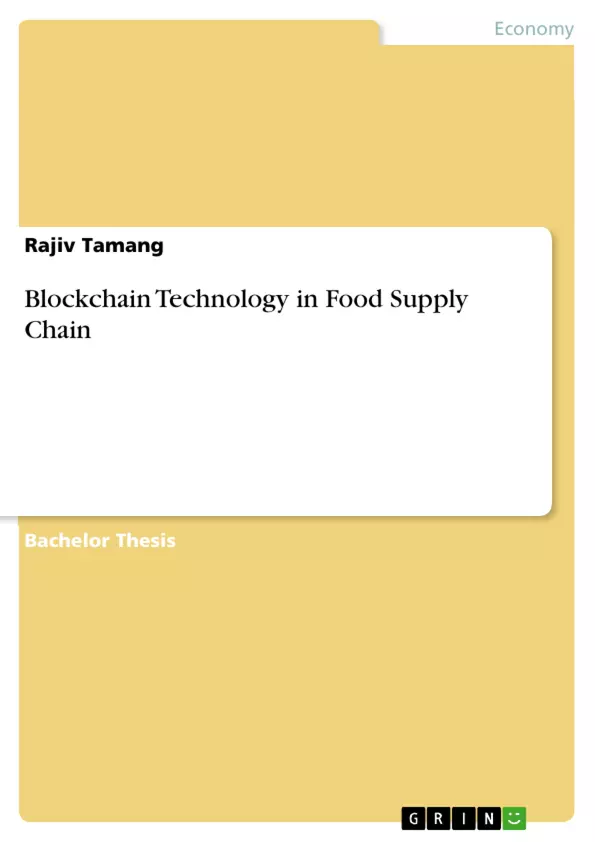The primary purpose of this paper is to provide an overview of the implementation of blockchain technology in the food supply chain by showing its potential to build trust among the stakeholders and to make the food supply chain efficient and cost-effective. A comprehensive literature review covering books, articles, journals, news, and expert opinions has been conducted to address the research questions.
The findings in the thesis lead to the conclusion that blockchain is a promising technology that has the potential to transform the food supply chain. Blockchain is capable of building consumer trust, providing information about the food we consume, and making the food traceability easier. Furthermore, it builds transparency among the stakeholders. Last but not least, it makes the food chain cost-effective by automating most of the transactions and eliminating paperwork and intermediaries. This paper ends with a discussion of some challenges in implementing blockchain due to its early phases of development.
Inhaltsverzeichnis (Table of Contents)
- Acknowledgement
- Table of Figures
- Abbreviations
- Abstract
- 1 Introduction
- 2 Foundation of Blockchain Technology
- 2.1 History and Definition
- 2.2 Public versus Private Blockchain
- 2.3 Peer-to-peer (P2P) Network
- 2.4.1 Hashing in the blockchain
- 2.4.2 Public-Private key
- 2.4.3 Digital Signatures
- 2.5 Consensus Algorithm
- 2.5.1 Proof of Work (PoW)
- 2.5.2 Proof of Stake (POS)
- 2.6 Smart Contracts
- 3 Food Supply chain
- 3.1 Introduction
- 3.2 The Actors in a Food Supply Chain
- 3.3 Current Issues in Food Supply Chains
- 3.3.1 Food Safety
- 3.3.2 Food Waste
- 3.3.3 Growing Regulations
- 3.3.4 Increasing Supply Chain Costs
- 3.4 Food Scandals
- 3.5 Summary
- 4 Blockchain-based Food Supply Chain
- 4.1 Traceability in Food Supply Chain
- 4.1.1 Traceability in the Seafood Industry
- 4.1.2 Meat and Poultry Traceability
- 4.2 Transaction Automation with Smart Contracts
- 4.3 Advantages of Blockchain from the Actor's Perspective
- 4.3.1 Producer's (Farmer) Perspective
- 4.3.2 Food Processer's Perspective
- 4.3.3 Food Trader's Perspective
- 4.3.4 Consumer's Perspective
- 4.4 Challenges in Implementation
- 4.4.1 High implementation Cost
- 4.4.2 Operational Challenges
- 4.4.3 Sustainability Challenges
- 4.5 The Case of Walmart
- Conclusion
- Bibliography
Zielsetzung und Themenschwerpunkte (Objectives and Key Themes)
This thesis explores the application of blockchain technology in the food supply chain. It aims to assess the potential benefits and challenges of implementing blockchain for improving food safety, traceability, and efficiency. The thesis delves into the foundational principles of blockchain technology and analyzes its relevance in the context of the food industry.
- Blockchain Technology in Food Supply Chain
- Food Safety and Traceability
- Smart Contracts and Transaction Automation
- Challenges and Opportunities for Blockchain Implementation
- Case Study: Walmart's Blockchain Initiative
Zusammenfassung der Kapitel (Chapter Summaries)
- Chapter 1 introduces the concept of blockchain technology in the context of food supply chain management, highlighting its potential for improving food safety, traceability, and efficiency.
- Chapter 2 delves into the foundational principles of blockchain technology, exploring its history, core concepts, and key features such as cryptography, consensus algorithms, and smart contracts.
- Chapter 3 examines the structure and challenges of the traditional food supply chain, analyzing current issues such as food safety, waste, regulations, and rising costs. The chapter also explores the impact of food scandals on consumer trust and industry practices.
- Chapter 4 investigates the application of blockchain technology in the food supply chain, focusing on its potential to enhance traceability, automate transactions, and improve transparency. The chapter examines the benefits of blockchain for various stakeholders, including producers, processors, traders, and consumers. It also explores challenges related to implementation costs, operational complexities, and sustainability.
Schlüsselwörter (Keywords)
Blockchain, food supply chain, food safety, traceability, smart contracts, transaction automation, consensus algorithms, food waste, regulations, implementation challenges, sustainability, case study, Walmart.
- Arbeit zitieren
- Rajiv Tamang (Autor:in), 2022, Blockchain Technology in Food Supply Chain, München, GRIN Verlag, https://www.grin.com/document/1323666



